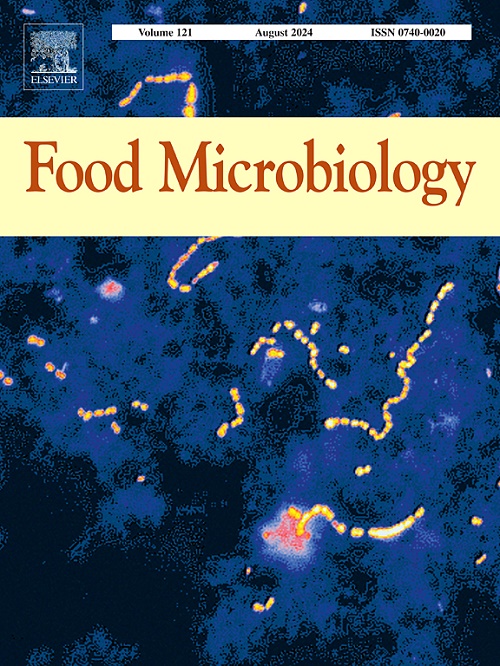Impact of radio frequency inactivation on bacterial DNA and membrane integrity in meat-based food model systems with various microstructures
IF 4.5
1区 农林科学
Q1 BIOTECHNOLOGY & APPLIED MICROBIOLOGY
引用次数: 0
Abstract
Radio Frequency (RF) bacterial inactivation has been successfully used in several food products. However, RF dielectric heating can be affected by several factors, including food composition. Changes in the food matrix can not only influence microbial inactivation but also potentially alter RF inactivation mechanisms. Despite this, limited studies have been conducted to understand RF heating in different food matrices and its inactivation mechanisms. In the present study, three meat-based model systems were used (Liquid, Emulsion and Aqueous gel) for RF inactivation of Listeria monocytogenes and Salmonella Typhimurium at 27.12 MHz. The presence of fat and gel in the matrix increased L. monocytogenes heat resistance only at mild temperatures (<60 °C) compared to liquid. On the contrary, S. Typhimurium inactivation rate was always slower in the presence of fat and gel in the matrix than in liquid during the whole RF treatment. dsDNA integrity did not show significant differences between treated and untreated samples, while cell membrane was damaged during RF heating for both microorganisms. Thus, RF microbial inactivation can be directly affected depending on the organisms and the medium complexity (e.g. fat, gel). Regarding RF inactivation mechanisms at 27.12 MHz, this study found no evidence of nonthermal effects. However, further research at the microscopic level is needed in order to better understand RF inactivation mechanisms.
射频失活对不同微结构肉类食品模型系统中细菌DNA和膜完整性的影响
射频(RF)细菌灭活已成功地应用于几种食品。然而,射频介质加热会受到几个因素的影响,包括食品成分。食物基质的变化不仅会影响微生物的失活,还可能改变RF的失活机制。尽管如此,有限的研究已经进行,以了解射频加热在不同的食物基质和它的失活机制。在本研究中,采用三种基于肉类的模型体系(液体、乳液和水凝胶)在27.12 MHz下对单核增生李斯特菌和鼠伤寒沙门菌进行射频灭活。与液体相比,基质中脂肪和凝胶的存在仅在温和温度(60°C)下增加了单核增生乳杆菌的耐热性。相反,在整个RF处理过程中,基质中存在脂肪和凝胶时,鼠伤寒沙门氏菌的失活速度始终比液体中慢。dsDNA完整性在处理过的和未处理过的样品之间没有显着差异,而两种微生物的细胞膜在射频加热过程中都被破坏。因此,RF微生物失活可以直接受到影响,这取决于生物体和介质复杂性(例如脂肪,凝胶)。关于27.12 MHz的射频失活机制,本研究没有发现非热效应的证据。然而,为了更好地了解射频失活机制,需要在微观水平上进行进一步的研究。
本文章由计算机程序翻译,如有差异,请以英文原文为准。
求助全文
约1分钟内获得全文
求助全文
来源期刊

Food microbiology
工程技术-生物工程与应用微生物
CiteScore
11.30
自引率
3.80%
发文量
179
审稿时长
44 days
期刊介绍:
Food Microbiology publishes original research articles, short communications, review papers, letters, news items and book reviews dealing with all aspects of the microbiology of foods. The editors aim to publish manuscripts of the highest quality which are both relevant and applicable to the broad field covered by the journal. Studies must be novel, have a clear connection to food microbiology, and be of general interest to the international community of food microbiologists. The editors make every effort to ensure rapid and fair reviews, resulting in timely publication of accepted manuscripts.
 求助内容:
求助内容: 应助结果提醒方式:
应助结果提醒方式:


